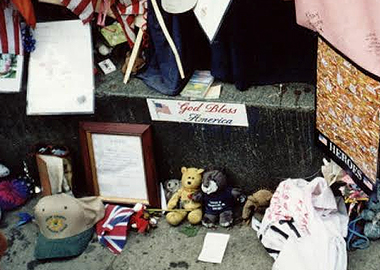Mark Schaming is the director of the New York State Historical Museum in Albany. Soon after September 11, 2001, he organized an exhibition called “The World Trade Center,” the first such visual documentation of the terrorist attacks and their aftermath.
Much of the show’s impact was created through the display of everyday objects: keys, badges, a fire alarm, signs, and posters, along with piles of unrecognizable debris.
As the National September 11 Memorial and Museum opened this past week, Schaming was interviewed about the process of collecting and showing such highly charged objects. He remembered how in the earlier exhibition, “people would come in and cry in the gallery, just seeing the simplest object.”
Early responses from the museum in lower Manhattan show something similar: visual, tangible engagements with simple objects stir the passions. (Holland Cotter called it a “gut-punch experience.”)
The Memorial and Museum architects and designers (Davis Brody Bond, LLP and Thinc Design), continually refer to the space as “sacred,” and suggest people will make “pilgrimage” to the site. The language is more than mere museum visitor attending a public institution. The space is hallowed ground.
We secular people may not believe we are fetishists, bowing to divine sculptures for help in fertility and war, but our responses at memorials and museums show that we at least continue to be functional animists. There is an animating force at work within the material realm. Objects may or may not be living beings, but they do a very good job of conveying information, evoking emotion, and triggering memory.
Which is why objects stand at the heart of the September 11 Museum, and why objects are the primary building material of religious traditions.
Many of the objects we saw around Ground Zero over the years were collected, cataloged, and archived by city, state, and federal employees. Tens of thousands of objects—from flowers to missing posters, teddy bears to crumpled metal—have been saved in various archives. They have been sorted through, and some have been put on display in the new museum where a general public encounters them in order to remember.
All museums memorialize. It’s part of their function even when we are looking for inspiration. The muses congregate near the mausoleum. Nonetheless, this new space wants to be sure we get the connection, and identifies as a “Memorial and Museum.”
Within this process of collecting, curating, and displaying, the objects morph, shift, and develop. They transform from everyday, forgettable objects, to emotionally powerful sites of memory. In a further progression, as Schaming notes, after a few years of having the objects on display, there is a transformation from the “from the sacred to the historical.” The rawness fades, the keen recollections are blunted. And then comes the work of memory.
As we head into the Memorial Day weekend, and perhaps pause for a moment to actually remember something, we are reminded again of why objects, not doctrines, stand at the heart of religious tradition. Objects make us who we are, and who we have been. Animists we will always be.
Over this weekend, a hundred thousand Nones and Christians, Muslims and atheists, will pass under the footprints of the World Trade Towers and be struck by the power of objects, and take part in rituals both ancient and modern.


